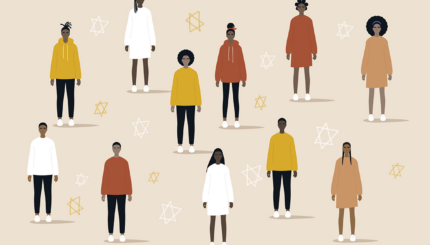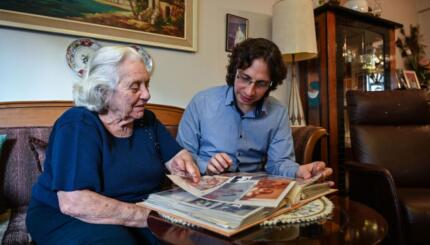Before the establishment of the state of Israel, Arabs were portrayed in locally produced films as primitive and exotic, compared to the Jewish pioneers, who were seen as modern and industrious. Arabs rode donkeys and used old-fashioned plows to work the land, whereas the Jews used mechanized equipment to dig for water, cultivate the land, and pave the roads. Arabs were part of the quaint local landscape, often depicted visually together with images such as camels, palm trees swaying in the breeze, and barren desert.
These early films did not provide an in-depth understanding of the local Arabs or their culture, and neglected to portray them as individuals. In fact, Arabs were portrayed as peripheral characters, and their roles were played by dark-skinned Sephardic Jews.
In the Galilee
Arabs continued to be portrayed as one-dimensional characters and visual symbols–and only appeared in supporting roles–until the Israeli political and psychological realities began to change in the 1980s. At that time, a major feature film was produced that grappled with relations between Jews and Arabs, set against the background of life in the agricultural area of the Galilee in northern Israel.
|
|
|
An image from the 1982 film Hamsin, directed by Daniel Wachsmann |
Hamsin (Daniel Wachsmann, 1982) is still considered a landmark production because of its brutal honesty and intensity and because it was the first attempt at tackling this difficult subject. The film centers on the relationship between a cattle rancher and his young Arab hired hand, and it touches on issues of land expropriation, the difficulties Arabs faced being accepted within Jewish society, the growth of Arab nationalism, and the sensitive subject of sexual relations between Arab and Jew.
At about the same time, another film was produced about Arab-Jewish relations in the Galilee–this time from an Israeli-Arab point of view. Wedding in Galilee (Michel Khleifi, 1987) is a story of tensions between Israeli military authorities and Arab villagers during the 1950s and early 1960s, when Arabs in the Galilee were still under military law. The first feature film directed by an Israeli Palestinian Arab, Wedding in Galilee deals with generational differences in political consciousness, family tensions, and sexual inadequacies.
Common Destiny
Films have been produced that explore the basic bonds of common destiny between Arab and Jew. In Beyond the Walls (Uri Barbash, 1984) and Cup Final (Eran Riklis, 1991) outside forces cause the Jews and Arabs to forge an otherwise unlikely alliance.
|
|
|
An image from the 1991 film Cup Final, directed by Eran Riklis |
Beyond the Walls is a hard-hitting film about life in a maximum security prison, where Arab political prisoners and Jewish hard-core criminals live side-by-side. Acclaimed both in Israel and abroad, the film was awarded the Critics’ Prize at Venice and an Academy Award nomination for Best Foreign Picture.
In the tense prison atmosphere, which includes homosexual rape, arson, and murder, Jews and Arabs are seen as victims of the cruel warden. The film challenges political and social stereotypes and portrays larger-than-life characters. It leaves one with a clear metaphor of Arab and Jew being locked up together, banding together against a common enemy, condemned to mutual acceptance and coexistence.
Similar to Beyond the Walls, Cup Final leads the viewer along a road toward the possibilities of mutual understanding: The conclusion, however, is less optimistic. With the 1982 War in Lebanon serving as a backdrop, the film explores the themes of male bonding during wartime, the relationship between captor and captive, and the possibility of coexistence in the politically tense atmosphere of the Middle East.
Understanding One’s Enemy
Any possibility of achieving understanding and coexistence in Israeli society is complicated by the fact that Israel has been in a continuous state of war with its Arab neighbors since its existence. For the first 19 years following Israel’s 1948 independence, the Arabs in the region comprised the major power bloc both militarily and politically. Following the war of 1967, however, there was a giant turning of the tables, and suddenly they found themselves as the losers in battle. At that time, the Jews, who had been the underdog for thousands of years, found themselves in a position of strength. Avanti Popoli (Rafi Bukaee, 1986) explores this reversal of roles and makes a plea for understanding the humanity of the Arab enemy.
During the final hours of the 1967 Six Day War, two Egyptian soldiers are desperately trying to find their way back to the Suez Canal. When they happen across an Israeli patrol, using the only language they have in common–the language of the theater–one of the Egyptians, a professional actor, recites the monologue from Shylock. He is begging for water and understanding at the same time: “I am a Jew. Has not a Jew eyes, emotions, senses? Do we not bleed?” With this reference to Shylock, director/scriptwriter Rafi Bukaee is saying to his Israeli film-going public, You were an oppressed minority in the Diaspora; now it is time for you to understand and empathize with the oppressed minority within your midst.
Avanti Popolo is about perceiving the human being behind the face of the enemy. Although it refers to wartime, it is a metaphor for the greater understanding of Arabs in general, on both sides of the border. The need for developing a better understanding and relationship between Jews and Arabs within Israel is the theme of two additional films produced in the 1980s. Marriage of Convenience (Haim Bouzaglo, 1988) is a comedy told from the middle-class Israeli point of view, and Nadia (Amnon Rubinstein, 1986) is from the point of view of an Israeli Palestinian teenage girl.
Realism & Surrealism in the Territories
The effects of the military occupation of the West Bank on the relations between Jews and Arabs have been examined in The Smile of the Lamb (Shimon Dotan, 1986), an adaptation of the book by award-winning novelist David Grossman. Both a political and literary film, it focuses on the growing political awareness of an old Arab wise man who sprinkles his food with the soil of the land –“When I finish eating all my land, I can die in peace.” Turkish actor Tuncel Curtiz won a prize at the 1986 Berlin Film Festival for this role.
Although Smile of the Lamb provides no solutions to the problems between Arabs and Jews in the territories, it does offer insight into emotional issues such as friendship and trust, and political issues such as confrontation, occupation, and coexistence.
Conclusion
During the 1990s, as the peace process developed, fewer films dealt with Arab-Jewish issues on the Israeli screen. Following Cup Final in 1991, two allegorical feature films were produced dealing with relations between Arabs and Jews: The Flying Camel (Rami Na’aman, 1994) and Circus Palestine (Eyal Halfon, 1998). The first is a statement about Jews and Palestinians rebuilding elements of the past and working together for a common future. The second is a complex film that takes place in a Palestinian town under Israeli occupation.
Some of the films about Arabs and Arab-Jewish relationships produced in Israel during the last 20 years are deeply pessimistic, ending in violence. Others offer a vision of coexistence and mutual support even in the midst of brutality and war. There are also films that make a plea for better understanding between the two groups. All of the films, however, reflect a rising consciousness among Israeli filmmakers–both Jewish and Arab–of the new regard for Arab-Jewish relations within Israeli society.
With your help, My Jewish Learning can provide endless opportunities for learning, connection and discovery.
Sephardic
Pronounced: seh-FAR-dik, Origin: Hebrew, describing Jews descending from the Jews of Spain.




